Preprint
Article
Human Salivary Microbiota Diversity According to Ethnicity, Sex, TRPV1 Variants and Sensitivity to Capsaicin
Altmetrics
Downloads
68
Views
37
Comments
0
A peer-reviewed article of this preprint also exists.
supplementary.zip (56.84KB )
This version is not peer-reviewed
Submitted:
02 October 2024
Posted:
03 October 2024
You are already at the latest version
Alerts
Abstract
The salivary microbiota of Italian and sub-Saharan African individuals was investigated using Nanopore Sequencing Technology (ONT- Oxford Nanopore Technologies). We detected variations in community composition in relation to endogenous (ethnicity, sex and diplotypic variants of the TRPV1 gene) and exogenous (sensitivity to capsaicin) factors. The results showed that, Prevotella, Haemophilus, Neisseria, Streptococcus, Veillonella and Rothia, are the most abundant genera, in accordance with the literature. However, alpha diversity and frequency spectra differed significantly between DNA pools. The microbiota in African, male, TRPV1 bb/ab diplotype and capsaicin low sensitive DNA pools was more diverse than Italian, female, TRPV1 aa diplotype and capsaicin high sensitive DNA pools. Relative abundance differed at phylum, genus and species level.
Keywords:
Subject: Biology and Life Sciences - Biology and Biotechnology
1. Introduction
The microbial communities resident at different sites of various anatomical locations in the body, indicated as the microbiota, has been proven to have a role in its host’s physiological functions such as metabolism, immune development, and behavioral responses and therefore in health and diseases [1]. The Human Microbiome Project (HMP)[2] has recognized the presence of a central microbiome (core) and a variable microbiome. The first represents the genomic complex of taxa equal for each habitat and individuals, which constitutes a very small portion of the totality, about 5-10%. The second is the genomic complex of taxa that changes between body districts and individuals, in relation to factors such as host genotype, lifestyle and physiological state. The oral habitats, compared to other body sites, show higher alpha diversity (diversity within a sample) but lower beta diversity (diversity between samples). This indicates that the oral site shows more heterogeneity in terms of microbiome than other body habitats, being second only to the gut [3,4].
The six most abundant phyla are, Firmicutes, Bacteroidetes, Proteobacteria, Actinobacteria, Fusobacteria and Spirochaetes. These account for about 96% of the total taxa found in the samples analysed so far. The most common genera are, Streptococcus, Eubacterium, Selenomonas, Veillonella (Firmicutes), Actinomyces, Atopobium, Rothia (Actinobacteria), Neisseria, Eikenella and Campylobacter (Proteobacteria), Fusctobaeria and Leptotrichia, (Fusobacteria), Prevotella, Capnocytophaga and Porphyromonas (Bacteriodetes) [3,4,5,6].
The relative abundance of the detected microorganisms in the oral cavity is affected by the sampled sites, being saliva one of them [3]. The salivary microbiota has attracted attention in the last decade and has been proven its stability over a reasonable period [7], making it a reliable biomarker. Saliva collection, storage and DNA extraction methods have also been studied and compared, indicating that they do not have a major influence on microbiome profiles [8], thus confirming saliva as a reliable and significant sample of the human oral microbiota.
The salivary microbiota is affected by endogenous factors such as age, sex, ethnicity and host genotype [9,10,11,12,13]. Therefore, can undergo significant and reversible changes due to the influence of external factors such as diet, smoking and intake of antibiotics or alcohol [9,14,15,16,17,18,19]. Oral microbiota variability factors are also confirmed from other sample sites, and, among others, we remand to some papers worth reading for the relevance of the considered sample [20,21] or the kind of study (longitudinal) [22].
While oral microbiota appears to modulate taste perception of the host through metabolite production, influencing dietary preferences, some researchers have identified a relationship between taste receptors genetics and oral microbiota composition [23,24], due to the capability of some bitter taste receptors to respond to bacterial molecules by activating innate immunity [25,26,27]. Transient receptor potential (TRP) channels, involved in physical and chemical stimuli sensing, able to respond to temperature, pH, osmolarity, pheromones and plant compounds [28,29], have also been proven to have a role as sensors of bacterial endotoxins and quorum sensing molecules [30,31]. But while their role in shaping the gut microbiota has been broadly investigated (for an extensive review see [32]), very little has been done regarding their contribution to oral microbiota composition [33].
Capsaicin, a vanillylamide, is the main secondary metabolite conferring the chemesthetic property of hotness to plants of the genus Capsicum through the activation of TRPV1 (transient receptor potential vanilloid 1) [34]. The other receptors responsible of chemesthetic sensations in the oral cavity and the nose are TRPM8 (melastatin, coolness) and TRPA1 (ankyrin, pungency) [29]. To our knowledge, capsaicin has been extensively studied for its role in the composition of the gut microbiota [35,36,37], not in the composition of the oral one.
A paper was recently published on the effect of mint oils on the composition of human oral microbiome, but the possible contribution of TRPM8 has not been investigated [38].
The TRPV1 activation threshold temperature (around 42 °C in humans) is lowered by vanilloids and several other natural compounds, such as piperine in pepper and gingerols in ginger. pH values below 6, a level easily reached by tissue injury due to infection and inflammation, are also able to activate it [39], conferring to TRPV1 a role in the process of injury-related hyperalgesia, inflammation, and pain [40]. Two haplotype blocks in the TRPV1 gene (H1 and H2) showed haplotypes with a variability pattern, compatible with a stabilizing selection model (frequencies around 50%, significantly positive Tajima’s D values), only in individuals with sub-Saharan African origin. The two regions have been used to investigate the correlation with body composition and sensitivity to capsaicin [41]. Significative differences were observed for body composition parameters but not for capsaicin sensitivity. African women carrying the H1-b and H2-b haplotypes, showed a lower extracellular fluid retention and a higher percentage of fat mass, whereas no significant association was found in men.
In this study we used Nanopore Sequencing Technology (ONT- Oxford Nanopore Technologies) to sequence the metagenome of salivary microbiota in male and female volunteers of Italian and sub-Saharan African ancestry. We aimed at investigating whether endogenous (ethnicity, sex, TRPV1 diplotypic variants) and exogenous (sensitivity to capsaicin) factors are related to changes in the oral microbiota.
2. Results
2.1. Quality control
The total reads obtained were 651,199. From these we filtered out the reads classified as Homo sapiens (577,759), as root (8,738), those unclassified (54,520), those showing classification inconsistency (55), those with single counts (N=1, 1,883). Overall, the reads which passed the filtering were 20,924 (Figure 1).
2.2. Comparisons Between Human Salivary Microbiota Communities
Analytical results by taxonomic levels are summarised in Tables S1-9.
2.2.1. Ethnic Differences
The comparison by ethnicity was performed by comparing the salivary DNA pool (pDNA) of sub-Saharan Africans (AFR, reads=7,321) with the pDNA of Italians (ITA, reads=2,931).
At the phylum level (Tables S1, S4, S7), the AFR pool showed a more diverse salivary microbiota (Shannon Diversity Index H: AFR=1.61 vs. ITA=1.41, t= 9.73; p<< 0.05). Six phyla - Proteobacteria, Bacteroidetes, Firmicutes, Actinobacteria, Fusobacteria and Spirochaetes - occupied almost 96% of the total in both groups, in accordance with the literature [3]. Also at the genus level (Figure 2, Tables S2, S5, S8), the frequency was significantly different (t = 13.46; p<<< 0.05), with the AFR pool showing a more diverse (Shannon H: AFR=2.89, ITA=2.41) microbiota. An increase between 4 and 6% of the genera Rothia, Veillonella and Streptococcus was observed in the AFR pool. A similar increase for Neisseria (5.4%) and a much more marked increase for Prevotella (18.6%) was observed in the ITA pool. At the species level (Tables S3, S6, S9), the differences mirrored those observed at the level of the upper taxonomic ranks (Shannon H: ITA = 3.43, AFR = 3.87; t = 11.32, p<< 0.05). Interestingly, the contribution of two species of the genus Haemophylus (H. parahaemolyticus +9.4% in the ITA pool, and H. parainfluenza +9.0% in the AFR pool) was not detectable at the genus level.
2.2.2. Differences Between Sexes
The comparison by sex was performed by comparing the pDNA of the males (M, reads=4,467), with the pDNA of the females (F, reads=5,785).
At the phylum level (Tables S1, S4, S7), the diversity between the two pools was significant (Shannon H: t=3.11; p< 0.05). The M pool has a more diverse salivary microbiota (H=1.61) than pool F (H=1.55). The more abundant phyla were Bacteroidetes in the M pool, Firmicutes and Actinobacteria in the F pool. At the genus level as well (Figure 3, Tables S2, S5, S8), the difference between diversity indices was significant (t=13.71; p<<<0.05), with the M pool (H=2.97) showing a more diverse microbiota composition than the female pool (H=2.59). An increase between 4 and 6% of the genera Rothia, Veillonella and Neisseria was observed in the F pool, while an increase of the genus Porphyromonas (3.4%) was observed in the M pool. At the species level (Tables S3, S6, S9), the differences reflected those of the higher taxonomic rank levels (Shannon H: M=4.01, F=3.66; t = 11.60, p<< 0.05).
We also investigated whether sex differences would affect ethnic differences. When the different pDNAs were disaggregated (Table S5, S8), only comparisons between ITA/AFR males showed a significant difference at the genus level (Shannon H: ITA-M = 2.18, AFR-M = 3.07; t=13.91, p<<<0.05), not between females (Shannon H: ITA-F = 2.44, AFR-F = 2.52; t=1.82, p>0.05). This suggests that the most diverse oral microbial community of African males may affect both sex and ethnic differences.
2.2.3. Differences between TRPV1 Diplotypes
The comparison by TRPV1 H1 diplotypes was performed only on sub-Saharan Africans, subdivided into individuals bearing diplotypes aa (AploA, reads=4,290) and individuals bearing diplotypes bb/ab (AploB, reads=3,031).
At the phylum level (Tables S1, S4, S7), the diversity (Shannon H) between the two pools was significant (t=3.96; p< 0.05). The AploB pDNA showed a more diverse salivary microbiota (H=1.65) than the AploA pDNA (H=1.56). At the genus level (Figure , Tables S2, S5, S8), the difference between diversity indices was higher (t=11.73, p<0.05), with the AploB pool showing a more diverse microbiota profile (H=3.02) than the AploA pool (H=2.66). The genera Prevotella and Veillonella were observed more abundant in the AploA pool whereas only the genus Porphyromonas showed an appreciable increase in the AploB pool (Figure 4B). At the species level (Tables S3, S6, S9), the results reflect those obtained at the genus and phylum level (Shannon H: AFRA=3.70, AFRB=3.97; t = 7.85, p <0.05).
We noticed that the differences in taxa reflected those found between sexes. Accordingly, we repeated the analysis dividing the pools in male Africans with diplotype aa (AploA-M), male Africans with diplotype bb (AploB-M), female Africans with diplotype aa (AploA-F), and female Africans with diplotype bb/ab (AploB-F). At the genus level (Table S5, S8), only comparisons between males showed a significant difference (Shannon H: AploAM=2.82, AploBM=3.12; t=6.95, p<0.05), contrary to females (Shannon H: AploAF=2.51, AploBF=2.54; t=0.56, p>0.05). Therefore, males with diplotype TRPV1 bb possess the most diverse microbial community.
2.2.4. Differences in capsaicin sensitivity
The comparison between the microbiota of individuals with different sensitivity to capsaicin was performed considering salivary pDNA of individuals with high sensitivity (HS, reads=7,630) and low sensitivity (LS, reads=12,836).
At the phylum level (Tables S1, S4, S7), the diversity between the two pools was significant (Shannon H: t=8.20; p<<0.05). The HS pool showed a more diverse salivary microbiota (H=1.39) than the LS pool (H=1.28). The more abundant phyla were Proteobacteria in the LS pool, Firmicutes and Actinobacteria in the HS pool. At the genus level (Figure 5, Tables S2, S5, S8), the two pools showed less different diversity values (t=3.11, p<0.05), with the HS microbiota slightly more diverse (Shannon H: HS=2.69; LS=2.62;). The greater increase was for the genus Escherichia in the LS pool (+10.2%), for Veillonella and Streptococcus in the HS pool (Figure 5B). At the species level as well (Tables S3, S6, S9), the two groups differed significantly (t=4.74; p< 0.05), with a higher diversity microbiome for the HS pool (Shannon H: HS=3.75, LS=3.65). Haemophilus parainfluenzae is the more abundant species in the HS pool (+6.9%), H. pitmaniae and E. coli in the LS pool.
To investigate whether ethnicity influenced the diversity observed, HS and LS pDNAs were disaggregated according to ethnicity: Italians with high sensitivity (ITA-HS), Italians with low sensitivity (ITA-LS), Africans with high sensitivity (AFR-HS), Africans with low sensitivity (AFR-LS). At the genus level (Tables S5, S8), only comparisons between Italians showed a significant difference (Shannon H: ITA-HS=2.75, ITA-LS = 2.61; t=5.16, p<0.05), not between Africans (AFR-HS=2.46, AFR-LS=2.50; 1.16, p>0.05). To investigate whether sex affected diversity results, the pDNAs were divided into males with high (HS-M) and low (LS-M) sensitivity, and females with high (HS-F) and low (LS-F) sensitivity. At the genus level (Table S5, S8), only male comparisons gave a significant difference (Shannon H: HS-M=2.51, LS-M=2.41; t=2.67, p << 0.05), not female comparisons (Shannon H: HS-F=2.61, LS-F=2.59; t= 0.77, p >0.05). Therefore, individuals with high sensitivity showed a more diversified salivary microbiota. This finding is emphasized according to sex (males) and ethnicity (Italians).
3. Discussion
Saliva is considered a reservoir and even a fingerprint of the entire oral microbiota, although not representative of the entire population of oral districts.
Despite critical points as unintentional sampling, suboptimal DNA quality (stored at -20 °C for 4 years), and the fact that oral microbiota studies are affected by the different sequencing approaches used [42] our results seem to suggest a satisfactory reliability of the methodological approach. The rarefaction curves (Figure S1) of the aggregated pDNAs reached a plateau, indicating a suitable depth of sequencing and the overall results agree with the literature, confirming that the oral microbiota is formed by a more stable core and a more variable spectrum of taxa. The variations between the different groups concerned mainly changes in relative abundances of taxa, rather than changes in the presence/absence of single microorganisms. Therefore, our results can be considered a new contribute to understanding the variations in composition of the human oral microbiota.
We found significant variations in salivary microbial diversity based on ethnicity, sex, genetic diversity (TRPV1 diplotypes) and chemesthetic perception (sensitivity to capsaicin). Sub-Saharan Africans showed a more diversified and richer microbiota than the Italians, with a greater abundance of the genera Streptococcus and Veillonella (Firmicutes), and Rothia (Actinobacteria). This finding agrees with the studies of Yang et al. [43]and Li et al. [11], in which Africans showed a more diverse microbiota than Germans, native Alaskan and native Americans. Furthermore, our data confirm that ethnicity exerts selective pressure on the oral microbiota as previously stated by Mason and colleagues [44].
Several studies have shown how a habitual diet can determine changes in the composition of the intestinal microbiota, particularly the Mediterranean one, characterized by intake of cereals, fruits and vegetables in greater quantities than other European diets [45,46]. It is therefore possible to hypothesize a substantial influence of the nutrients typical of the Mediterranean diet (vitamins B and E), polyphenols and other bioactive compounds on the composition of the oral microbiota.
The comparison between sexes reported an increase of the genera Rothia, Veillonella and Neisseria in the females compared to males, despite the latter showed a richer and more diversified microbiota. To date, there are few studies about this comparison. However, in the work of Murugesan and collaborators [13], on the population of Qatar, such evaluation did not recognize a significant difference in the two groups, even if the females were more abundant for Treponema and Mycoplasma. In a more recent study [47], distinct differences in the predominant microbial genera between females and males were found. For females, the most abundant genera included Streptococcus, followed by Prevotella and Granulicatella. In contrast, the saliva of males showed a different profile, with Campylobacter A being the most prevalent followed by Veillonella, Porphyromonas, and Oribacterium. The significant differences in salivary microbiota composition between the sexes, indicates that gender plays a crucial role in defining the microbial diversity and abundance in the mouth.
This is one of the first studies investigating the influence of genetic variability on the oral microbiota. We demonstrated that individuals with haplotype TRPV1 H1-b, in the homozygous or heterozygous state, were richer in taxa than the carriers of the haplotype TRPV1 H1-a. In the study of Giannì and collaborators [41] a correlation between TRPV1 diplotypes and body composition of adaptive type was hypothesized, consisting of responses controlled by different diplotypes in response to heterogeneous environmental conditions. In African women carrying the H1-b haplotype, a higher percentage of fat mass and lower extracellular fluid retention was observed. This suggesting the possible action of sex-driven balancing selection at the non-coding sequences of the TRPV1 gene, with advantageous adaptive effects for people living in arid areas with strong daily or seasonal temperature. Accordingly, the greater microbiota diversity of the H1-b haplotype carriers might be related to the more intense environmental and food fluctuations. More targeted studies are needed to verify this hypothesis.
As far as we know, this is the first study that correlated capsaicin sensitivity with salivary microbiota. Scientific community has focused the research on the link between capsaicin and gut microbiota. Therefore, although we are aware that there is often a close relationship, we could not make a direct comparison of our findings with literature. We can hypothesize that a lower sensitivity to capsaicin (possibly associated with a higher consumption of chili peppers and other hot food), may correspond to a reduction in the diversification of the oral microbiota. In fact, capsaicin, depending on its concentration and on bacterial strain, has been demonstrated to exert an inhibitory effect against several bacteria [48]. Furthermore, according to Menicagli, et al. [49], the intake of capsaicin leads to an increase in oxidative stress within the oral cavity, with increased production of malondialdehyde and later salivary nitric oxide), conditions involving physiological changes in the oral cavity. This change in oral "environmental" conditions could lead to an alteration of the microbiota in terms of a decrease in diversity and the spread of species with pathogenic potential (Escherichia coli +11%, Haemophilus pittmaniae +6.4%).
4. Materials and Methods
4.1. Sample Selection
The recruited samples (Table S1) were the same as in Giannì and colleagues (2024) [41]: 46 African healthy donors (AFR) (34 males and 12 females) originating in various sub-Saharan countries and 45 Italians (21 males and 24 females) (ITA). By signing a consent form in accordance with the current regulations on the processing of personal data, volunteers agreed to perform a sensory sensitivity test for capsaicin and donate a saliva sample for genetic analysis.
All extracted DNA samples were subjected to spectrophotometric analysis to assess their concentration (260/280 nm ratio) and purity (260/230 nm ratio). DNA samples showing the highest values were selected. Two regions of the TRPV1 gene were sequenced by the Cycle Sequencing method as previously reported [41].
4.2. Rapid barcoding Sequencing Kit (SQK-RBK004) and DNA Pool (pDNA)
Metagenomic analyses were performed by Nanopore sequencing technology (ONT- Oxford Nanopore Technologies) on the MINion device. Pools of DNA (pDNA) were created using DNA from different samples. Each pDNA consisted of a mixture of equal amounts of DNA per sample for a total of 400 ng.
To investigate differences based on ancestry and sex, we selected pDNAs with 16 Africans (8 males and 8 females) and 12 Italians (6 males and 6 females). To investigate differences based on genetic variants, we selected pDNAs with bb/ab TRPV1 diplotypes (8 Africans) and aa TRPV1 diplotypes (8 Africans). To investigate differences based on sensitivity to capsaicin we selected pDNAs from individuals at the extremes of a sensitivity scale from 1 to 10: volunteers with a 1-3 sensitivity (LS 10 Africans and 10 Italians) and 6-9 sensitivity (HS,10 Africans and 10 Italians) [41].
The kit SQK-RBK004 was used to label each pDNA for simultaneous sequencing runs. Doing this, to each pDNA has been assigned a specific barcode, via the barcode trasposome complex, which reduces the DNA into pair-end fragments and labels them with specific oligos. To each library have been added the Rapid Adapters (RAP) and a motor protein, to guide the individual fragments through the nanopores (flow cell R9.4.1).
4.3. Sequencing and Basecalling
Sequencing runs were set by the software MinKNOW version 20.10 (Oxford Nanopore Technology). It allowed to perform the hardware and flow cell check and to set the running parameters, such as duration (72h), voltage power (180mV), input and output folder and minimum signal quality (7). The base-calling (Fast Accuracy mode) was done through the Guppy software and the reads were saved in fastQ files.
4.4. Taxonomic Assignment
To get the taxonomic assignment of the reads that passed the quality control (passed), the EPI2ME software package was used. It allowed an end-to-end analysis of fastQ files via a cloud. For this study we used the algorithm WIMP (What’s In My Pot?). WIMP uses the KRAKEN algorithm, which can assign taxonomic labels to DNA sequences, through the use of k-mer with a speed higher than BLAST but with comparable accuracy. The algorithm works using a pre-constructed structure that maps oligonucleotides (k-mers) with a length of 24 bp at the taxonomic nodes of the NCBI reference tree. A taxon is assigned to the reads when, at the level of the individual nodes, the respective 24-mer diagnostics are recognized. Thanks to this procedure, the assignment is faster, as complete alignment to the original reference sequence is not required. The final output is a report containing a distribution of reads/taxon at different taxonomic levels (Phylum, Family, Genus, Species) and a tree of taxonomic units (OTUs) assigned to different levels of relative abundance of reads [50]. Once the reads were classified, they were subjected to a post-run quality check, consisting of the elimination of reads classified as Homo sapiens, "root", "unclassified" and those that showed an uncertain taxonomy. The reads that had only one occurrence (=1) were subsequently eliminated to avoid stochastic bias in index determination and statistical testing.
Relative abundances of taxa were calculated by simply dividing the occurrence value of the taxon in question by the total of the reads. The reads were then subjected to the rarefaction process before performing statistical analyses (Figure S1).
4.5. Statistical Analyses
4.5.1. Alpha Diversity
In ecology the term alpha diversity refers to the diversity within a single community or sample, and it allows describing the structure of an ecological community in terms of richness in species (the number of taxonomic groups detected within the sample). Another type of metric is represented by so-called diversity indices that allows to measure the distribution of taxa within the community.
For this project as alpha metrics we used the Richness (S) and the Shannon Diversity Index (H). Richness is the number of taxa in the sample compared to the total number of sequenced reads. The Shannon Diversity Index allows to describe how evenly the taxa are distributed within the sample. This index is one of the most widely used metrics to quantify the composition of an ecosystem, as both rare and common species are considered [51]. To perform pools rarefaction and calculate the different indices of alpha diversity (S and H) the vegan package of R was used, respectively through the function "rarefy" and "diversity".
4.5.2. Hutcheson T-test
We used the Hutcheson t-test, instead of the ordinary student t-test, to compare the differences between two pDNAs, in the absence of repeated observations. This is a non-parametric method that allows to compare two samples using only the values of the diversity index (Shannon H) and their variance. Thus, for communities with abundance in the order of hundreds or thousands of organisms, the critical value of significance (0.05) is about 1.96 [52]. The R-packages "ecoltest" and "Hutchetson t-test” were used.
Supplementary Materials
The following supporting information can be downloaded at the website of this paper posted on Preprints.org. The following supporting information can be downloaded at: Figure S1: Rarefection curves; Table S1: pDNA counts: phylum level; Table S2: pDNA counts: genus level; Table S3: pDNA counts: species level; Table S4: Alpha diversity: phylum level; Table S5: Alpha diversity: genus level; Table S6: Alpha diversity: species level; Table S7: Hutcheson t-test: phylum level; Table S8: Hutcheson t-test: genus level; Table S9: Hutcheson t-test: species level.
Funding
This research was supported by the University of Pisa (ex60% Grants to ST) and by the University of Gastronomic Sciences—Pollenzo (Grant to GM).
Author Contributions Conceptualization
S.T and G.M.; data curation, S.T.; formal analysis, E.V. and S.T.; investigation, E.V.; methodology, S.T.; resources, S.T.; software, E.V.; supervision, S.T., G.M. and C.P.; validation, E.V.; visualization, E.V.; writing—original draft, E.V. and S.T.; writing—review and editing, S.T., E.V., G.M. and C.P. All authors have read and agreed to the published version of the manuscript.
Institutional Review Board Statement
The study was conducted in accordance with the Declaration of Helsinki and approved by the Ethics Committee of the Università di Bologna (15.02.2016).
Informed Consent Statement
Informed consent was obtained from all subjects involved in the study. Written informed consent has been obtained from the patients to publish this paper.
Data Availability Statement
The original contributions presented in the study are included in the article/supplementary material; further inquiries can be directed to the corresponding author.
Acknowledgments
We are very grateful to all the people who agreed to participate in this study. We sincerely thank Maddalena Giannì for her help in the setting of the experimental analyses.
Conflicts of Interest
The authors declare no conflicts of interest. The funders had no role in the design of the study; in the collection, analyses, or interpretation of data; in the writing of the manuscript; or in the decision to publish the results.
References
- Aggarwal, N.; Kitano, S.; Puah, G.R.Y.; Kittelmann, S.; Hwang, I.Y.; Chang, M.W. Microbiome and Human Health: Current Understanding, Engineering, and Enabling Technologies. Chem Rev 2023, 123, 31–72.
- Turnbaugh, P.J.; Ley, R.E.; Hamady, M.; Fraser-Liggett, C.M.; Knight, R.; Gordon, J.I. The Human Microbiome Project. Nature 2007, 449, 804–810.
- Caselli, E.; Fabbri, C.; D’Accolti, M.; Soffritti, I.; Bassi, C.; Mazzacane, S.; Franchi, M. Defining the Oral Microbiome by Whole-Genome Sequencing and Resistome Analysis: The Complexity of the Healthy Picture. BMC Microbiol 2020, 20. [CrossRef]
- Deo, P.N.; Deshmukh, R. Oral Microbiome: Unveiling the Fundamentals. Journal of Oral and Maxillofacial Pathology 2019, 23.
- Aas, J.A.; Paster, B.J.; Stokes, L.N.; Olsen, I.; Dewhirst, F.E. Defining the Normal Bacterial Flora of the Oral Cavity. J Clin Microbiol 2005, 43, 5721–5732. [CrossRef]
- Lazarevic, V.; Whiteson, K.; Hernandez, D.; François, P.; Schrenzel, J. Study of Inter-and Intra-Individual Variations in the Salivary Microbiota; 2010;
- Belstrøm, D.; Holmstrup, P.; Bardow, A.; Kokaras, A.; Fiehn, N.E.; Paster, B.J. Temporal Stability of the Salivary Microbiota in Oral Health. PLoS One 2016, 11. [CrossRef]
- Lim, Y.; Totsika, M.; Morrison, M.; Punyadeera, C. The Saliva Microbiome Profiles Are Minimally Affected by Collection Method or DNA Extraction Protocols. Sci Rep 2017, 7. [CrossRef]
- Wells, P.M.; Sprockett, D.D.; Bowyer, R.C.E.; Kurushima, Y.; Relman, D.A.; Williams, F.M.K.; Steves, C.J. Influential Factors of Saliva Microbiota Composition. Sci Rep 2022, 12. [CrossRef]
- Nasidze, I.; Li, J.; Quinque, D.; Tang, K.; Stoneking, M. Global Diversity in the Human Salivary Microbiome. Genome Res 2009, 19, 636–643. [CrossRef]
- Li, J.; Quinque, D.; Horz, H.P.; Li, M.; Rzhetskaya, M.; Raff, J.A.; Hayes, M.G.; Stoneking, M. Comparative Analysis of the Human Saliva Microbiome from Different Climate Zones: Alaska, Germany, and Africa. BMC Microbiol 2014, 14. [CrossRef]
- Henne, K.; Li, J.; Stoneking, M.; Kessler, O.; Schilling, H.; Sonanini, A.; Conrads, G.; Horz, H.P. Global Analysis of Saliva as a Source of Bacterial Genes for Insights into Human Population Structure and Migration Studies. BMC Evol Biol 2014, 14. [CrossRef]
- Murugesan, S.; Al Ahmad, S.F.; Singh, P.; Saadaoui, M.; Kumar, M.; Al Khodor, S. Profiling the Salivary Microbiome of the Qatari Population. J Transl Med 2020, 18. [CrossRef]
- Hansen, T.H.; Kern, T.; Bak, E.G.; Kashani, A.; Allin, K.H.; Nielsen, T.; Hansen, T.; Pedersen, O. Impact of a Vegan Diet on the Human Salivary Microbiota. Sci Rep 2018, 8. [CrossRef]
- Ibarlucea-Jerez, M.; Monnoye, M.; Chambon, C.; Gérard, P.; Licandro, H.; Neyraud, E. Fermented Food Consumption Modulates the Oral Microbiota. NPJ Sci Food 2024, 8. [CrossRef]
- Nasidze, I.; Li, J.; Schroeder, R.; Creasey, J.L.; Li, M.; Stoneking, M. High Diversity of the Saliva Microbiome in Batwa Pygmies. PLoS One 2011, 6. [CrossRef]
- Murtaza, N.; Burke, L.M.; Vlahovich, N.; Charlesson, B.; O’neill, H.M.; Ross, M.L.; Campbell, K.L.; Krause, L.; Morrison, M. Analysis of the Effects of Dietary Pattern on the Oral Microbiome of Elite Endurance Athletes. Nutrients 2019, 11. [CrossRef]
- Mohammed, L.I.; Razali, R.; Zakaria, Z.Z.; Benslimane, F.M.; Cyprian, F.; Al-Asmakh, M. Smoking Induced Salivary Microbiome Dysbiosis and Is Correlated with Lipid Biomarkers. BMC Oral Health 2024, 24. [CrossRef]
- Adam, M.; Hasan, R. The Effects of E-Cigarette Use on the Oral Microbiome. Evid Based Dent 2023, 24.
- Burcham, Z.M.; Garneau, N.L.; Comstock, S.S.; Tucker, R.M.; Knight, R.; Metcalf, J.L.; Miranda, A.; Reinhart, B.; Meyers, D.; Woltkamp, D.; et al. Patterns of Oral Microbiota Diversity in Adults and Children: A Crowdsourced Population Study. Sci Rep 2020, 10. [CrossRef]
- Shen, J.; Chen, H.; Zhou, X.; Huang, Q.; Garay, L.G.; Zhao, M.; Qian, S.; Zong, G.; Yan, Y.; Wang, X.; et al. Oral Microbiome Diversity and Diet Quality in Relation to Mortality. J Clin Periodontol 2024. [CrossRef]
- Lif Holgerson, P.; Esberg, A.; Sjödin, A.; West, C.E.; Johansson, I. A Longitudinal Study of the Development of the Saliva Microbiome in Infants 2 Days to 5 Years Compared to the Microbiome in Adolescents. Sci Rep 2020, 10, 9629. [CrossRef]
- Rud, I.; Almli, V.L.; Berget, I.; Tzimorotas, D.; Varela, P. Taste Perception and Oral Microbiota: Recent Advances and Future Perspectives. Curr Opin Food Sci 2023, 51.
- Dong, H.; Liu, J.; Zhu, J.; Zhou, Z.; Tizzano, M.; Peng, X.; Zhou, X.; Xu, X.; Zheng, X. Oral Microbiota-Host Interaction Mediated by Taste Receptors. Front Cell Infect Microbiol 2022, 12.
- Zheng, X.; Tizzano, M.; Redding, K.; He, J.; Peng, X.; Jiang, P.; Xu, X.; Zhou, X.; Margolskee, R.F. Gingival Solitary Chemosensory Cells Are Immune Sentinels for Periodontitis. Nat Commun 2019, 10. [CrossRef]
- Medapati, M.R.; Bhagirath, A.Y.; Singh, N.; Schroth, R.J.; Bhullar, R.P.; Duan, K.; Chelikani, P. Bitter Taste Receptor T2R14 Modulates Gram-Positive Bacterial Internalization and Survival in Gingival Epithelial Cells. Int J Mol Sci 2021, 22. [CrossRef]
- Medapati, M.R.; Singh, N.; Bhagirath, A.Y.; Duan, K.; Triggs-Raine, B.; Batista, E.L.; Chelikani, P. Bitter Taste Receptor T2R14 Detects Quorum Sensing Molecules from Cariogenic Streptococcus Mutans and Mediates Innate Immune Responses in Gingival Epithelial Cells. FASEB Journal 2021, 35. [CrossRef]
- Damann, N.; Voets, T.; Nilius, B. TRPs in Our Senses. Current Biology 2008, 18.
- Roper, S.D. TRPs in Taste and Chemesthesis. Handb Exp Pharmacol 2014, 223. [CrossRef]
- Boonen, B.; Alpizar, Y.A.; Meseguer, V.M.; Talavera, K. TRP Channels as Sensors of Bacterial Endotoxins. Toxins (Basel) 2018, 10.
- Tobita, N.; Tsuneto, K.; Ito, S.; Yamamoto, T. Human TRPV1 and TRPA1 Are Receptors for Bacterial Quorum Sensing Molecules. J Biochem 2021, 170, 775–785. [CrossRef]
- Nagpal, R.; Mishra, S.K.; Deep, G.; Yadav, H. Role of TRP Channels in Shaping the Gut Microbiome. Pathogens 2020, 9, 1–16. [CrossRef]
- Evangeliou, E.; Plemmenos, G.; Chalazias, A.; Piperi, C. Impact of TRP Channels in Oral Pathology and Therapeutic Targeting Options: A Narrative Review. Curr Top Med Chem 2023, 23. [CrossRef]
- Caterina, M.J.; Schumacher, M.A.; Tominaga, M.; Rosen, T.A.; Levine, J.D.; Julius, D. The Capsaicin Receptor: A Heat-Activated Ion Channel in the Pain Pathway. Nature 1997, 389. [CrossRef]
- Rosca, A.E.; Iesanu, M.I.; Zahiu, C.D.M.; Voiculescu, S.E.; Paslaru, A.C.; Zagrean, A.M. Capsaicin and Gut Microbiota in Health and Disease. Molecules 2020, 25.
- Mahalak, K.K.; Bobokalonov, J.; Firrman, J.; Williams, R.; Evans, B.; Fanelli, B.; Soares, J.W.; Kobori, M.; Liu, L. Analysis of the Ability of Capsaicin to Modulate the Human Gut Microbiota In Vitro. Nutrients 2022, 14. [CrossRef]
- Xiang, Q.; Guo, W.; Tang, X.; Cui, S.; Zhang, F.; Liu, X.; Zhao, J.; Zhang, H.; Mao, B.; Chen, W. Capsaicin—the Spicy Ingredient of Chili Peppers: A Review of the Gastrointestinal Effects and Mechanisms. Trends Food Sci Technol 2021, 116, 755–765.
- Abdelrahman, S.M.; El Samak, M.; El-Baz, L.M.F.; Hanora, A.M.S.; Satyal, P.; Dosoky, N.S. Effects of Mint Oils on the Human Oral Microbiome: A Pilot Study. Microorganisms 2024, 12. [CrossRef]
- Tominaga, M.; Caterina, M.J.; Malmberg, A.B.; Rosen, T.A.; Gilbert, H.; Skinner, K.; Raumann, B.E.; Basbaum, A.I.; Julius, D. The Cloned Capsaicin Receptor Integrates Multiple Pain-Producing Stimuli. Neuron 1998, 21. [CrossRef]
- Julius, D. TRP Channels and Pain. Annu Rev Cell Dev Biol 2013, 29.
- Giannì, M.; Antinucci, M.; Bertoncini, S.; Taglioli, L.; Giuliani, C.; Luiselli, D.; Risso, D.; Marini, E.; Morini, G.; Tofanelli, S. Association between Variants of the TRPV1 Gene and Body Composition in Sub-Saharan Africans. Genes (Basel) 2024, 15, 752. [CrossRef]
- Oliveira, S.G.; Nishiyama, R.R.; Trigo, C.A.C.; Mattos-Guaraldi, A.L.; Dávila, A.M.R.; Jardim, R.; Aguiar, F.H.B. Core of the Saliva Microbiome: An Analysis of the MG-RAST Data. BMC Oral Health 2021, 21. [CrossRef]
- Yang, Y.; Zheng, W.; Cai, Q.; Shrubsole, M.J.; Pei, Z.; Brucker, R.; Steinwandel, M.; Bordenstein, S.R.; Li, Z.; Blot, W.J.; et al. Racial Differences in the Oral Microbiome: Data from Low-Income Populations of African Ancestry and European Ancestry. mSystems 2019, 4. [CrossRef]
- Mason, M.R.; Nagaraja, H.N.; Camerlengo, T.; Joshi, V.; Kumar, P.S. Deep Sequencing Identifies Ethnicity-Specific Bacterial Signatures in the Oral Microbiome. PLoS One 2013, 8. [CrossRef]
- Cani, P.D.; Van Hul, M. Mediterranean Diet, Gut Microbiota and Health: When Age and Calories Do Not Add Up! Gut 2020, 69.
- De Filippis, F.; Pellegrini, N.; Vannini, L.; Jeffery, I.B.; La Storia, A.; Laghi, L.; I Serrazanetti, D.; Di Cagno, R.; Ferrocino, I.; Lazzi, C.; et al. High-Level Adherence to a Mediterranean Diet Beneficially Impacts the Gut Microbiota and Associated Metabolome. Gut 2016, 65. [CrossRef]
- Liu, X.; Tong, X.; Jie, Z.; Zhu, J.; Tian, L.; Sun, Q.; Ju, Y.; Zou, L.; Lu, H.; Qiu, X.; et al. Sex Differences in the Oral Microbiome, Host Traits, and Their Causal Relationships. iScience 2023, 26. [CrossRef]
- Yohana, W.; Rafisa, A. Unlocking the Potential of Capsaicin in Oral Health (Review). Biomed Rep 2024, 21, 153. [CrossRef]
- Menicagli, R.; Marotta, O.; Maione, N. Possible Effects of Capsaicin (Chili Pepper) on the Oral Health. Int J Prev Med 2020, 11. [CrossRef]
- Wood, D.E.; Salzberg, S.L. Kraken: Ultrafast Metagenomic Sequence Classification Using Exact Alignments. Genome Biol 2014, 15. [CrossRef]
- Willis, A.D. Rarefaction, Alpha Diversity, and Statistics. Front Microbiol 2019, 10. [CrossRef]
- Hutcheson, K. A Test for Comparing Diversities Based on the Shannon Formula. J Theor Biol 1970, 29.
Figure 1.
Reads subjected to post-run quality control.
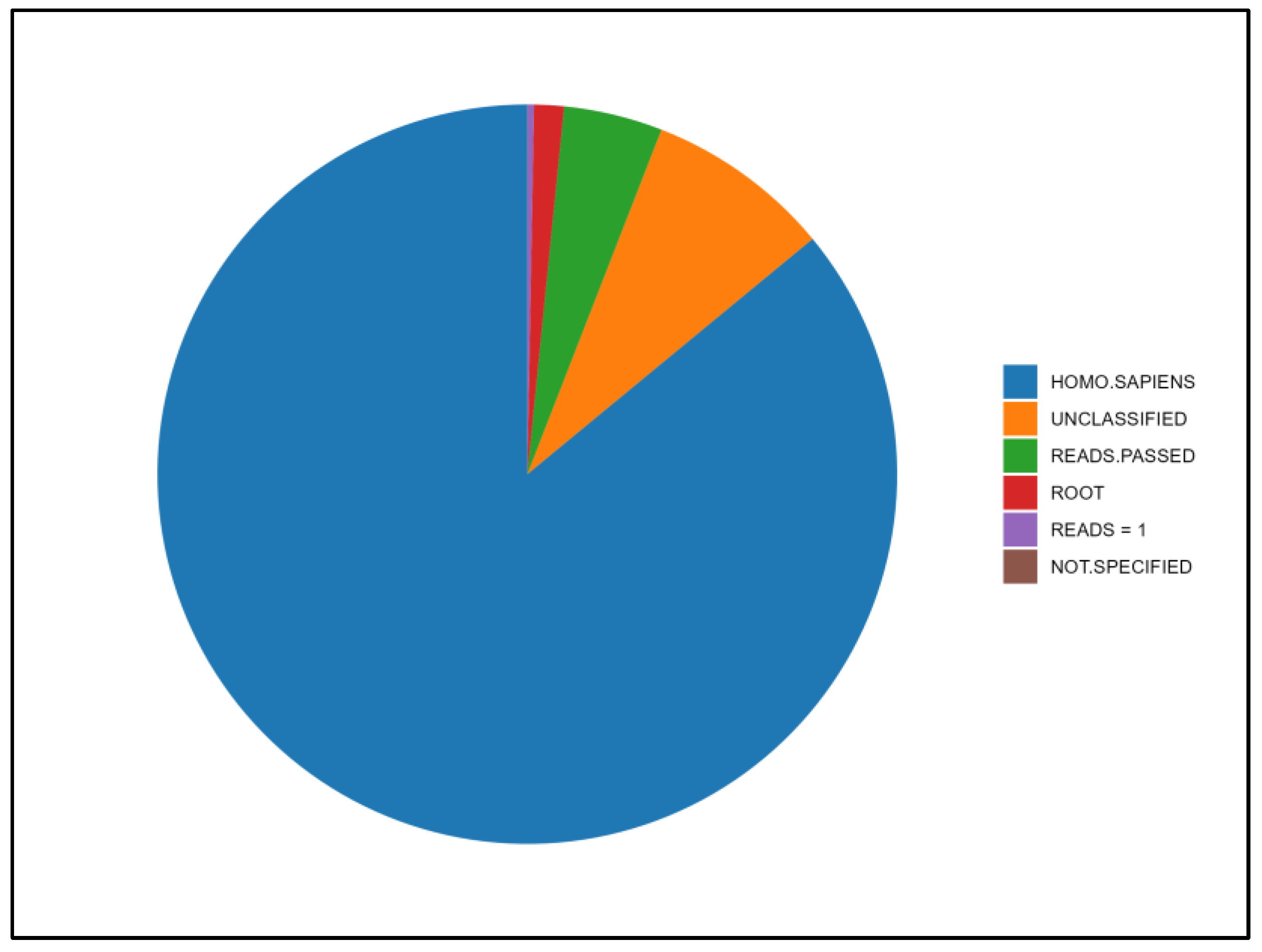
Figure 2.
Distribution of the more abundant taxa in sub-Saharan Africans (AFR) and Italians (ITA).
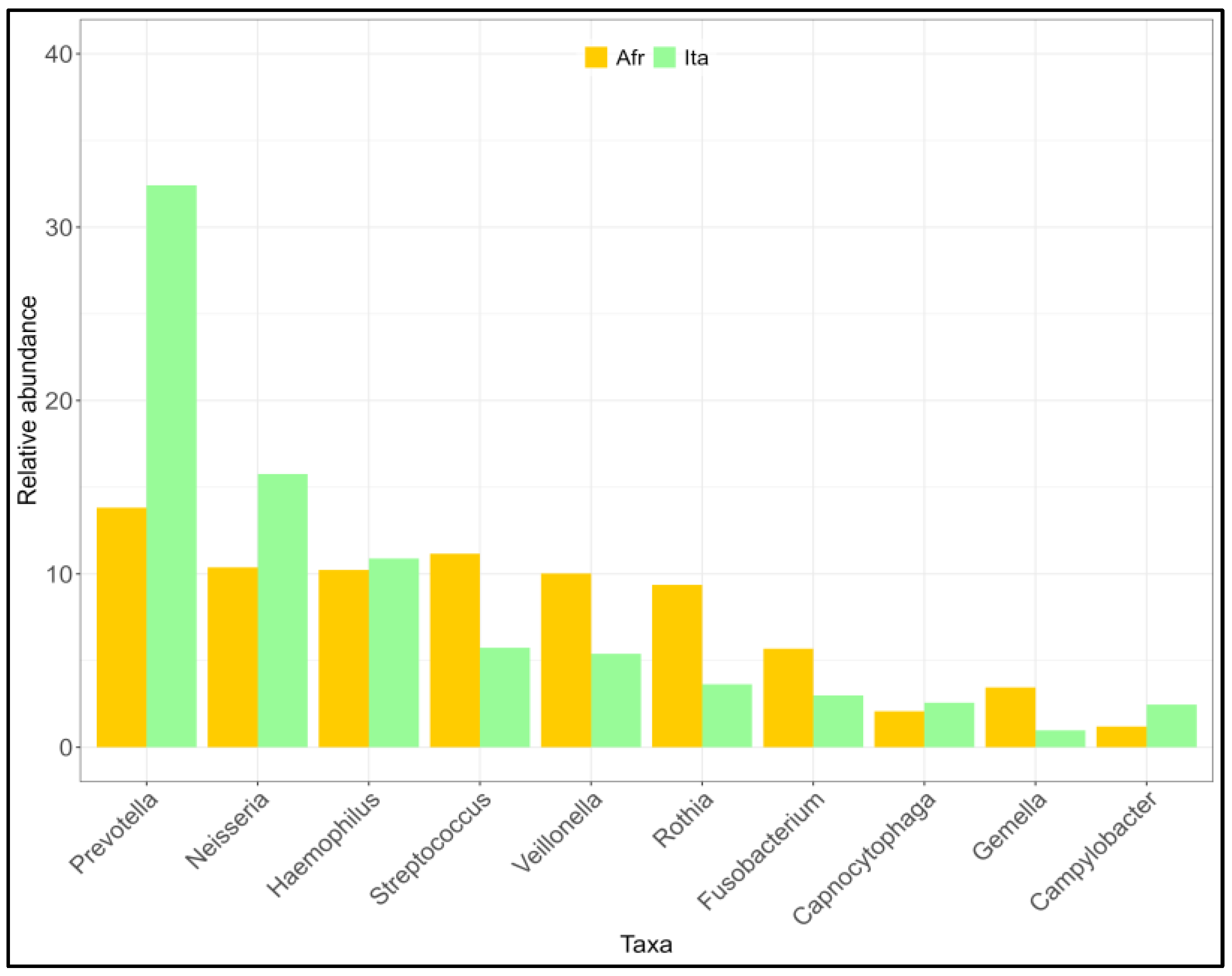
Figure 3.
Distribution of the more abundant taxa in males (M) and females (F).
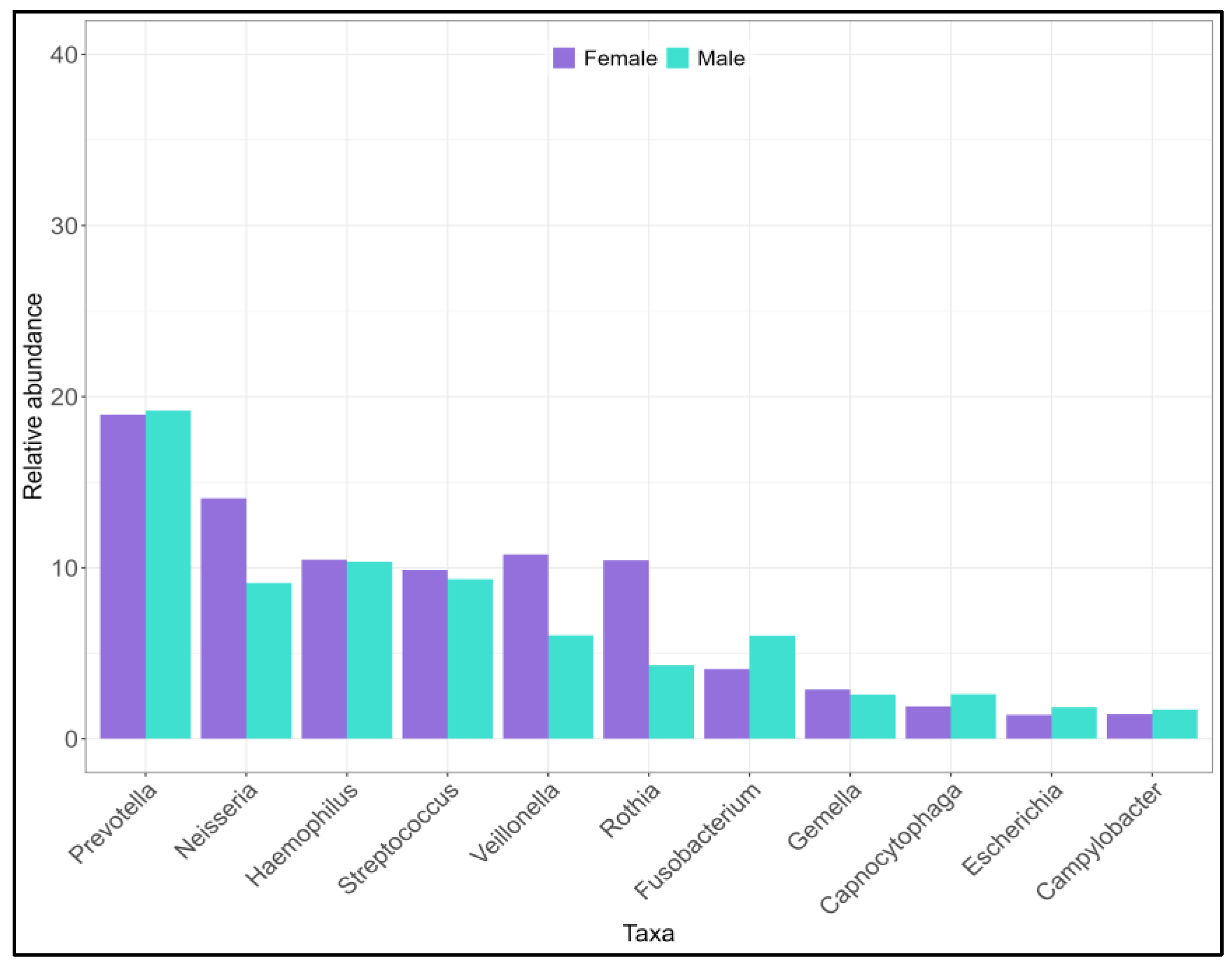
Figure 4.
Distribution of the more abundant taxa in the two TRPV1 diplotype pools (aa, AploA) and (bb/ab, AploB).
Figure 4.
Distribution of the more abundant taxa in the two TRPV1 diplotype pools (aa, AploA) and (bb/ab, AploB).
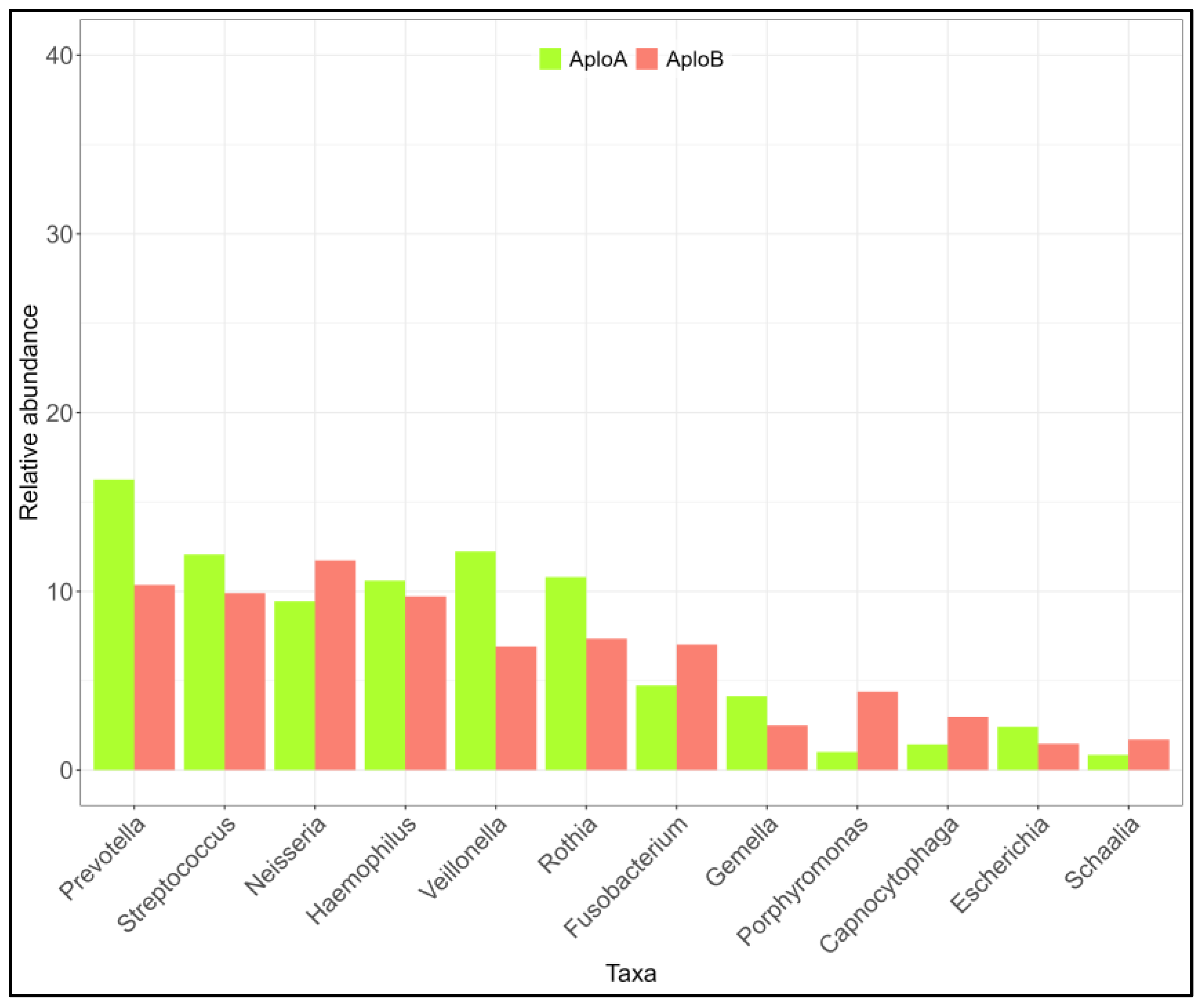
Figure 5.
Distribution of the more abundant taxa according to DNA pools with different sensitivity to capsaicin: high sensitivity (HS) and low sensitivity (LS).
Figure 5.
Distribution of the more abundant taxa according to DNA pools with different sensitivity to capsaicin: high sensitivity (HS) and low sensitivity (LS).
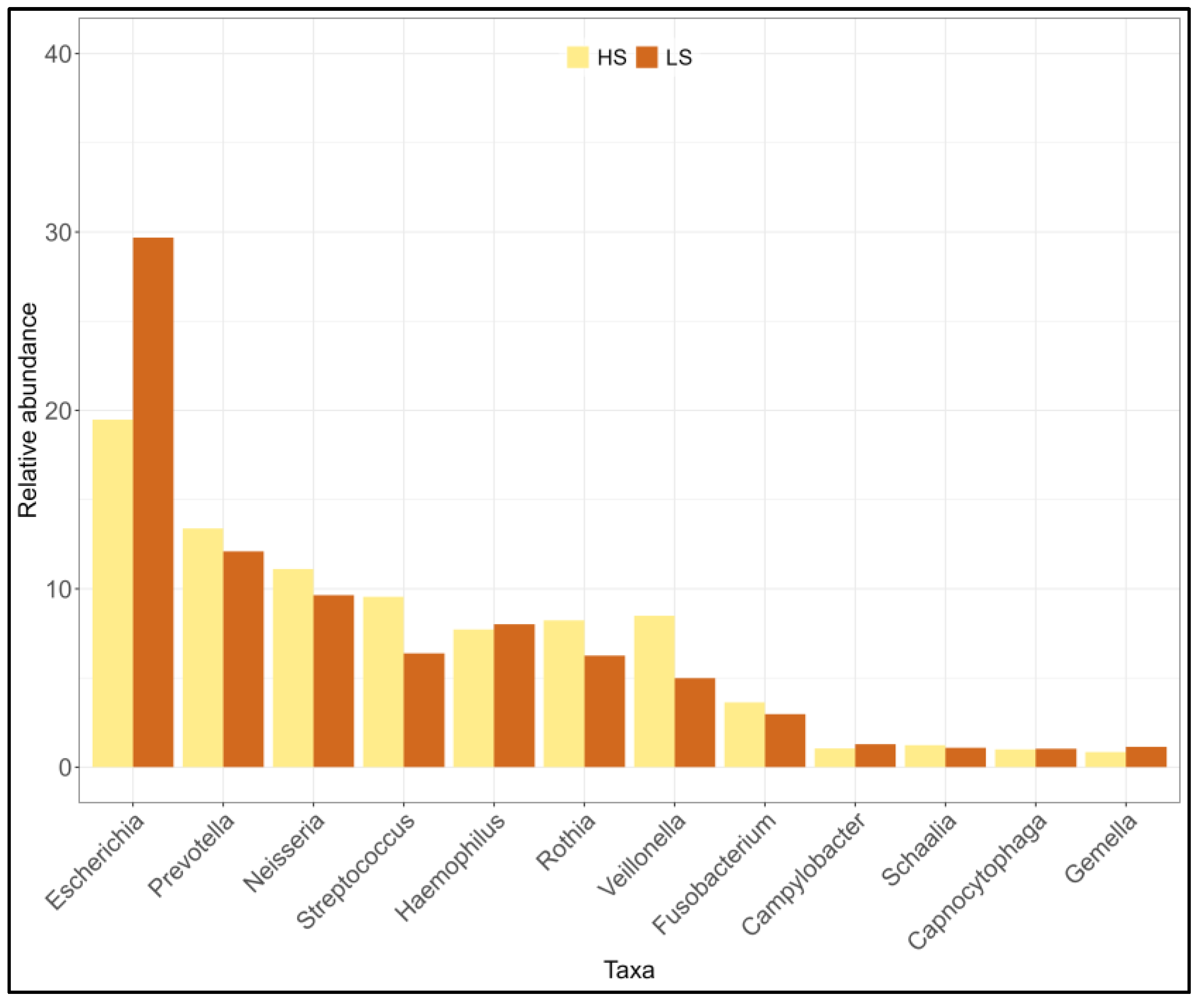
Disclaimer/Publisher’s Note: The statements, opinions and data contained in all publications are solely those of the individual author(s) and contributor(s) and not of MDPI and/or the editor(s). MDPI and/or the editor(s) disclaim responsibility for any injury to people or property resulting from any ideas, methods, instructions or products referred to in the content. |
© 2024 by the authors. Licensee MDPI, Basel, Switzerland. This article is an open access article distributed under the terms and conditions of the Creative Commons Attribution (CC BY) license (http://creativecommons.org/licenses/by/4.0/).
Copyright: This open access article is published under a Creative Commons CC BY 4.0 license, which permit the free download, distribution, and reuse, provided that the author and preprint are cited in any reuse.
MDPI Initiatives
Important Links
© 2024 MDPI (Basel, Switzerland) unless otherwise stated






